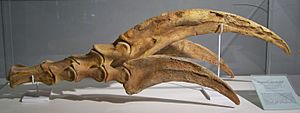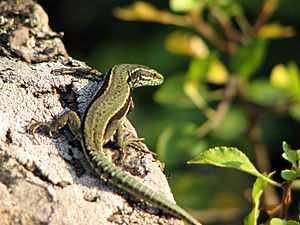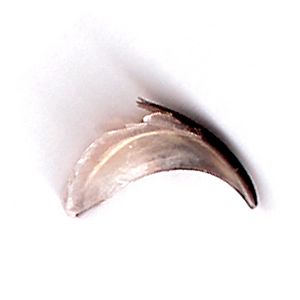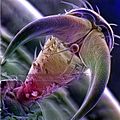Claw facts for kids
A claw is a sharp, curved part found at the end of a toe or finger. Many animals, like mammals, birds, and some reptiles, have claws. The word "claw" can also describe the pincer-like parts of creatures like crabs and lobsters.
Claws are made of a tough protein called keratin. Keratin is very strong and doesn't dissolve easily. It forms hard structures in animals like reptiles, birds, amphibians, and mammals.
Animals use their claws for many things. Meat-eating animals, like cats, use them to catch and hold their food. Other animals use claws for digging, climbing trees, or even for defense.
Things that are flat and don't come to a sharp point, like on humans, are called nails instead of claws.
Contents
What are Arthropod Claws?
For creatures like lobsters and crabs, the correct name for their "claw" is a chela (say: KEE-luh). If an animal has legs with chelae, those legs are called chelipeds. You might also hear chelae called pincers.
How Tetrapods Use Their Claws
Tetrapods are animals with four limbs, like mammals, birds, reptiles, and amphibians. Their claws are made of keratin and have two layers. Tetrapods use their claws in many ways. They commonly use them to grab or kill prey, to dig, and to climb or hang.
Bird Talons and Claws
A talon is the special name for the claw of a bird of prey. Talons are a bird's main tool for hunting. They are very important; without them, most birds of prey could not catch their food.
Some birds also use their claws for defense. For example, cassowaries use the large claws on their inner toe to protect themselves. All birds have claws, which they use to hold onto things and to protect the tips of their toes.
Mammal Claws: Retractable and More
All carnivores (meat-eating mammals) have claws. These claws can be very different in length and shape. Claws grow from the last bone in an animal's paw and are made of keratin.
Many predatory mammals have claws that can partly hide inside their paw. These are called protractile claws. The cat family, Felidae, is a great example, as almost all cats have fully retractable claws. A claw that can be pulled back is protected from getting worn down.
Most cats and dogs also have a dewclaw. This is a small claw found on the inside of their front paws. It's not used as much as the other claws, but it can help cats hold onto prey. Because the dewclaw doesn't touch the ground, it stays sharper and longer.
Claws grow in cycles, much like hair. When a new layer grows, the old layer can break off. This process takes several months for human fingernails.
You might see cats scratching on wood or special scratching posts to help remove old claw layers. Domesticated equids (like horses, donkeys, and mules) usually need a farrier to trim their hooves regularly.
Why Primates Have Nails, Not Claws
As primates (like monkeys and humans) evolved to have grasping hands and feet, claws were no longer needed for moving around. Instead, most of their fingers and toes developed nails.
Reptile Claws: For Climbing and Hunting

Most lizards have strong claws at the end of their toes. These claws form from the last scale on the toe. Reptiles have very well-developed claws. Lizard claws help them climb and hold down prey if they are meat-eaters.
Snakes do not have feet or claws. However, some large boids (like the Boa constrictor) have tiny leftover hind-limb bones that stick out with a single claw, called "spurs."
Amphibian Claws: A Rare Feature
The only amphibians that have claws are the African clawed frogs. It seems that claws developed separately in amphibians and in amniotes (reptiles, birds, and mammals).
Images for kids





